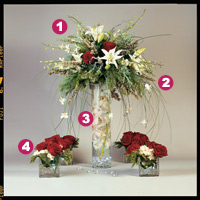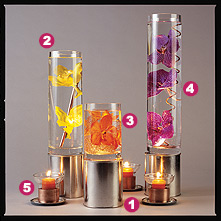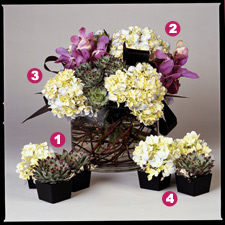Chicago asked three florists to share their secrets for making a party pop.
by Heather Blaha
 |
CHICAGO SCHOOL OF FLOWER DESIGN
A longtime instructor with design schools in Chicago and Milwaukee, director Michael Gaffney always goes for an elevated, dramatic centerpiece. DO-IT-YOURSELF: 1) In lieu of foam, use hydrangeas to anchor the arrangement. 2) Keeping in mind a lush, symmetrical look, Gaffney says, insert into the hydrangeas a mix of Casa Blanca lilies, hanging dendrobium orchids, red roses, and winter greens. 3) Place the resulting bouquet atop a cylindrical vase that has been filled first with cymbidiums and next with water. 4) Complement the large piece with four small glass cubes filled with hydrangeas, red roses, and a few small orchids. The result, says Gaffney, embodies the principle of radial design. “You really don’t have to be a creative genius.”
 |
BLUMEN
Head designer Paul Prentice and owner Amy Crum pictured something unexpected crafted out of objects that people might find at home or the hardware store. “It’s fun to think of new applications for familiar objects,” says Prentice; in this case, it’s paint cans and copper wire. DO-IT-YOURSELF: 1) To start, use a can opener to cut out the bottom of an empty paint can (available at the hardware store); insert an inexpensive plastic tap light. Set the paint lids aside. 2) Take two cymbidiums (tropical orchids) and tie them to a ten-inch replacement copper refill tube, using a small piece of a copper scouring pad as a tie for each. 3) Place four florets of orange Mokara orchids in the middle of a scouring pad. 4) Attach purple Rothschild orchids to a coil; Prentice makes his by stripping electrical wire of its plastic and wrapping the copper element around a broom to make a coil shape. Submerge each arrangement in water-filled glass vases. Place them on top of the paint cans. They will be illuminated from below by the plastic tap light in each can. 5) For a final touch, sit votive candles atop copper base end caps from the hardware store. Place the caps, in turn, upon the lids from the paint cans.
 |
LARKSPUR
Owner Beth Barnett manipulates florals with one simple rule in mind: “Start with the biggest flower if you’re not using a lot of greens.” She also promotes the idea of asymmetry, so that each person around a dining table can enjoy a different perspective. DO-IT-YOURSELF: 1) Craft a base out of river root, which Barnett says prevents flower stems from slipping and offers a more interesting look than a vase full of stems. (You can order river root from most florists for about $10.) 2) For the arrangement, choose five stems of light blue hydrangeas, plus purple Mokara orchids and succulents. To make the succulents easier to insert, Barnett attaches them to a stick. 3) Slice one or two large chocolate ti leaves into long strips; then loop and insert them into the piece. For a look of hanging leaves, pull the tail ends back out. 4) Barnett’s final touch-two-inch-square black metal containers that are filled with lichens, mosses, and succulents. “The hostess can send one home with each guest at the end of the evening.”
Photography: Grant Kessler


